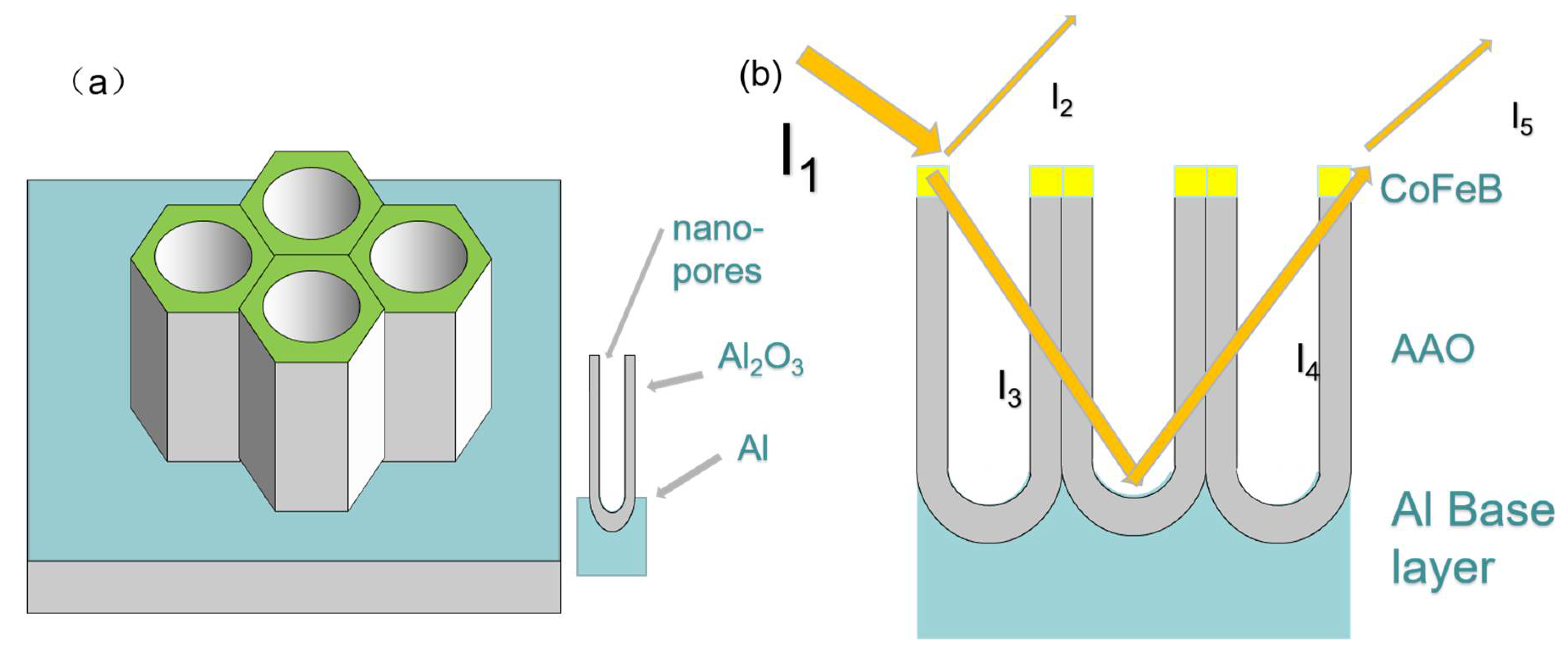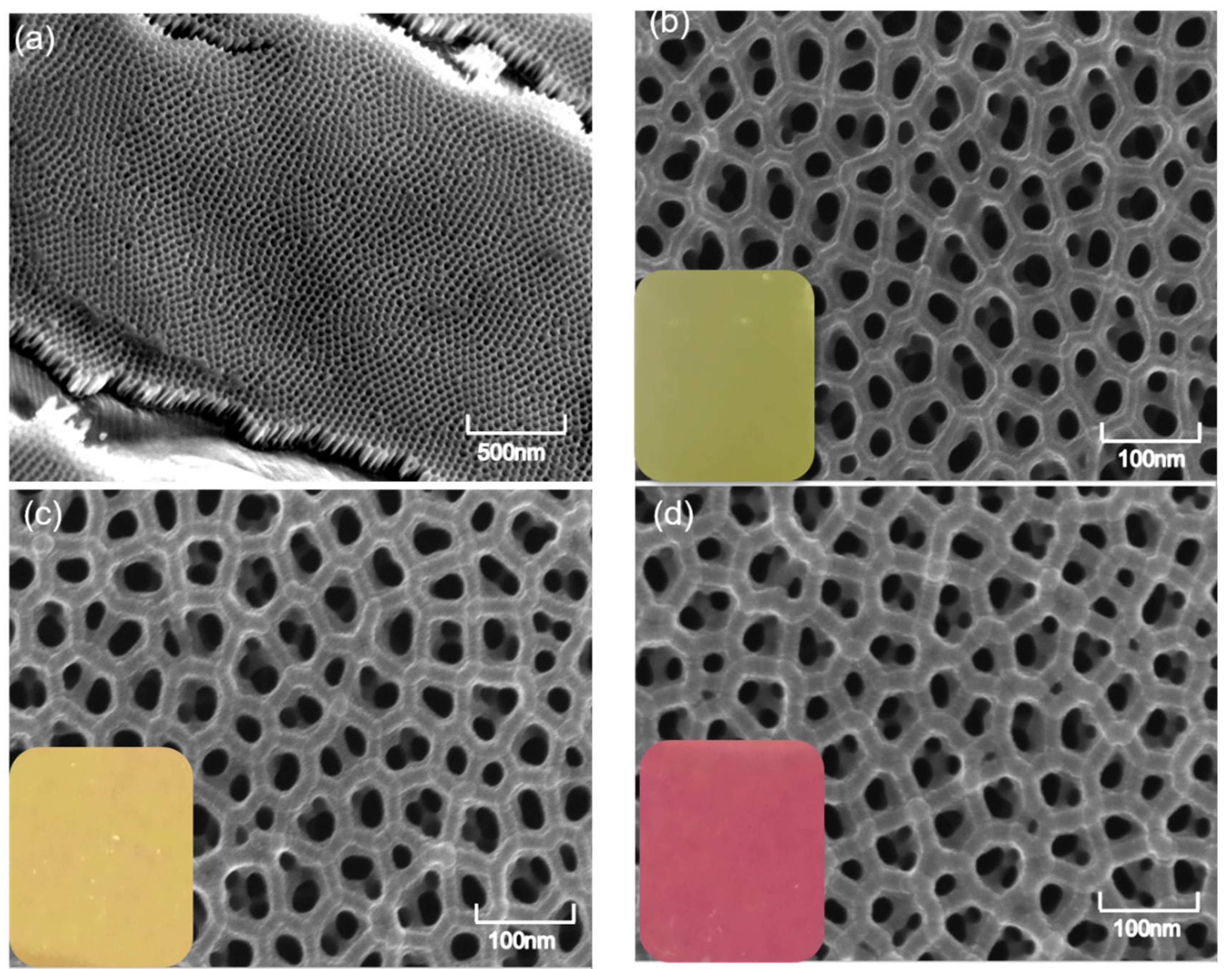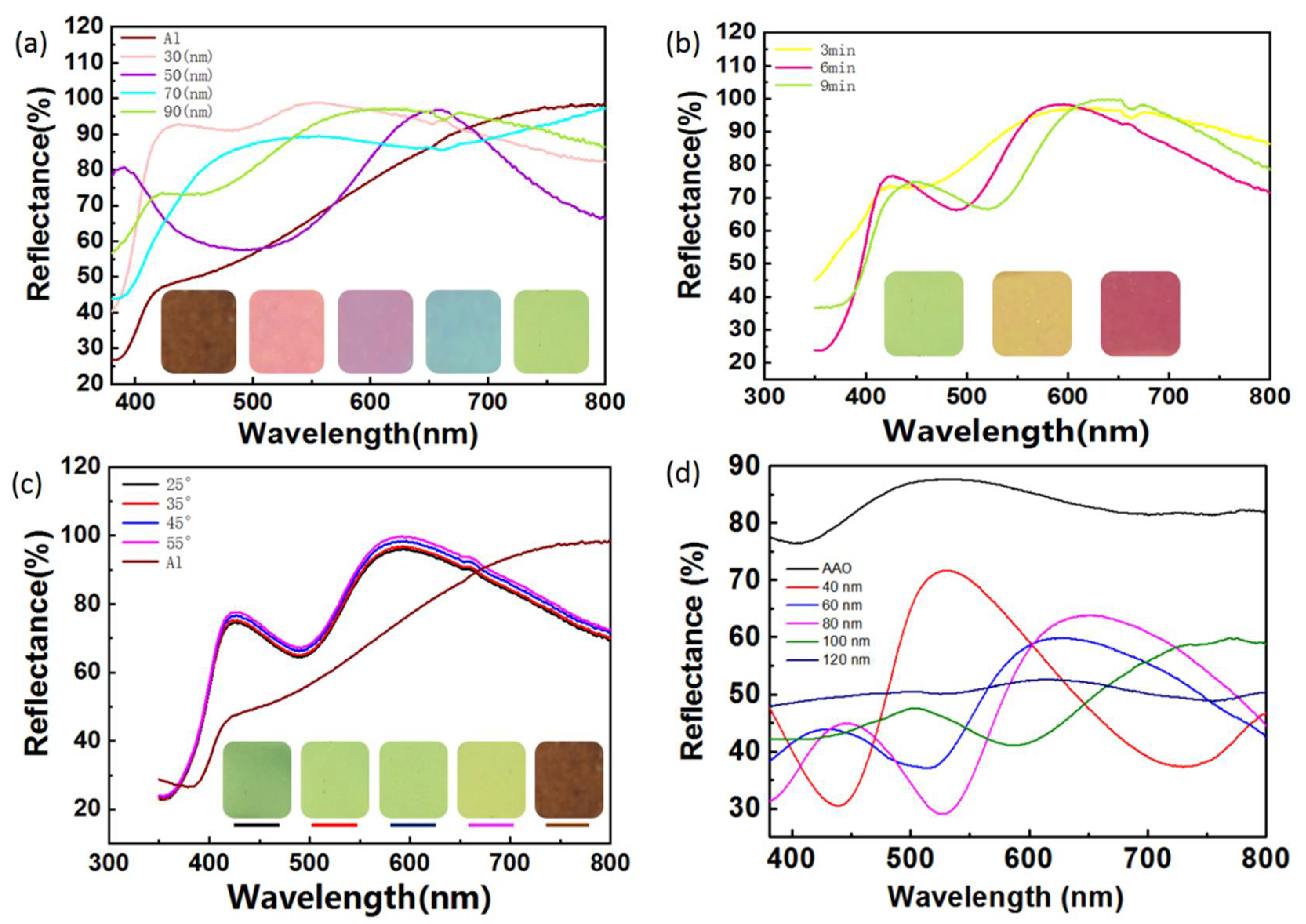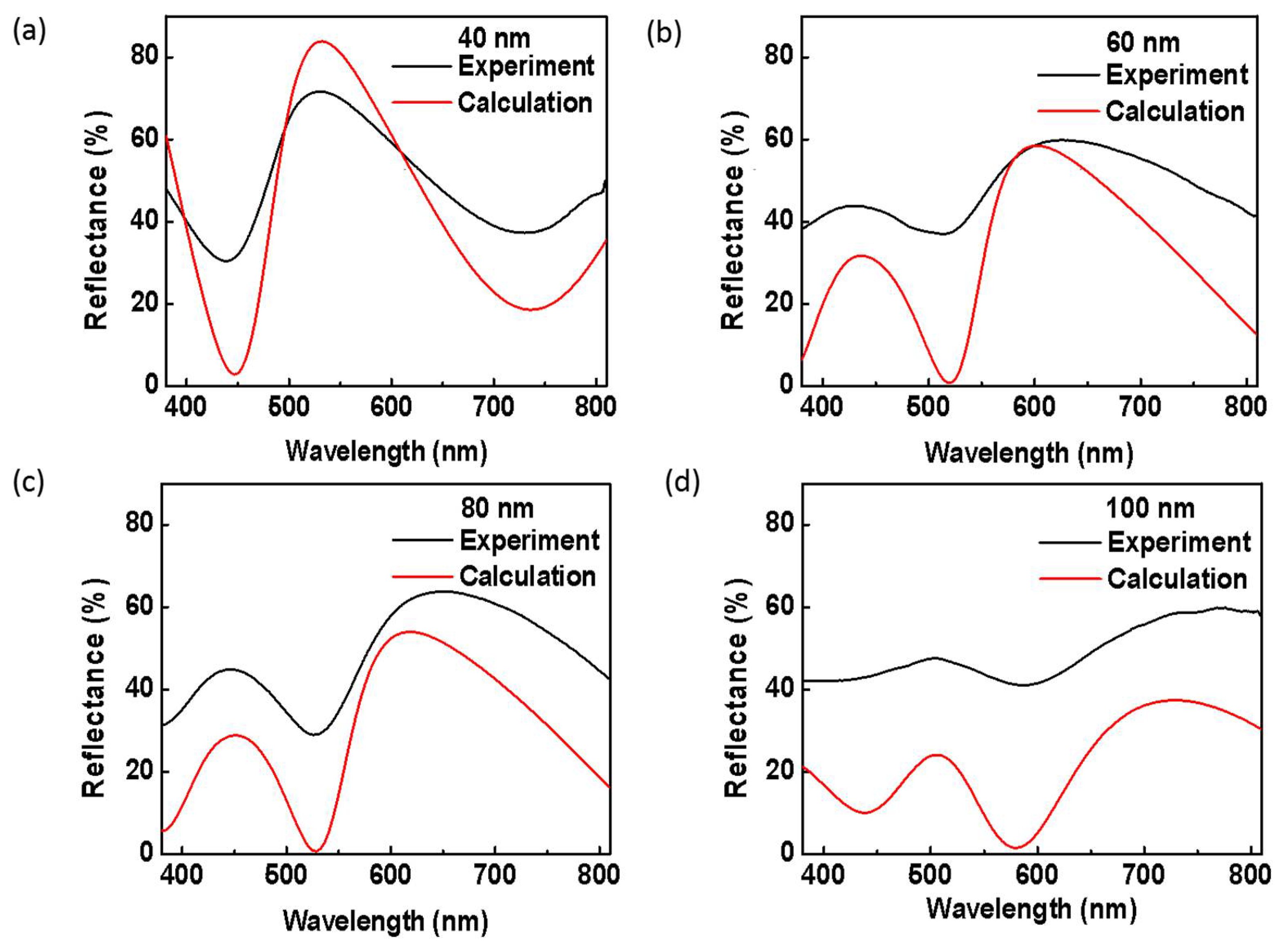Structural Color Control of CoFeB-Coated Nanoporous Thin Films
Abstract
:1. Introduction
2. Experimental Section
2.1. Sample Preparation
2.2. Characterization of the Morphology and Composition of CoFeB@AAO Films
[Y] = [0.212671 0.715160 0.072169] [G]
[Z] = [0.017758 0.109477 0.872765] [B]
3. Results and Discussion
4. Conclusions
Author Contributions
Funding
Institutional Review Board Statement
Informed Consent Statement
Data Availability Statement
Acknowledgments
Conflicts of Interest
References
- Zhao, Y.; Xie, Z.; Gu, H.; Zhu, C.; Gu, Z. Bio-Inspired Variable Structural Color Materials. Chem. Soc. Rev. 2012, 41, 3297–3317. [Google Scholar] [CrossRef] [PubMed]
- Shang, L.; Zhang, W.; Ke, X.; Zhao, Y. Bio-Inspired Intelligent Structural Color Materials. Mater. Horiz. 2019, 6, 945–958. [Google Scholar] [CrossRef]
- Lythgoe, J.N.; Shand, J. The Structural Basis for Iridescent Colour Changes in Dermal and Corneal Irddophores in Fish. J. Exp. Biol. 1989, 141, 313–325. [Google Scholar] [CrossRef]
- Gao, X.; Xin, Y.; Xi, Y.; Liang, X.; Lei, J. The Dry-Style Antifogging Properties of Mosquito Compound Eyes and Artificial Analogues Prepared by Soft Lithography. Adv. Mater. 2010, 19, 2213–2217. [Google Scholar] [CrossRef]
- Parker, A.R.; Mcphedran, R.C.; Mckenzie, D.R.; Botten, L.C.; Nicorovici, N. Aphrodite’s Iridescence. Nature 2001, 409, 36–37. [Google Scholar] [CrossRef]
- Sato, O.; Kubo, S.; Gu, Z.-Z. Structural Color Films with Lotus Effects, Superhydrophilicity, and Tunable Stop-Bands. Acc. Chem. Res. 2009, 42, 1–10. [Google Scholar] [CrossRef] [PubMed]
- Jang, J.; Badloe, T.; Yang, Y.; Lee, T.; Rho, J. Spectral Modulation through the Hybridization of Mie-Scatterers and Quasi-Guided Mode Resonances: Realizing Full and Gradients of Structural Color. ACS Nano 2020, 14, 15317–15326. [Google Scholar] [CrossRef] [PubMed]
- Lee, K.; Kim, H.; Kim, J.H.; Choi, D. Structural Color and near-Infrared Tunability of Ruthenium-Coated Anodic Aluminum Oxide by Atomic Layer Deposition. Scr. Mater. 2020, 187, 125–129. [Google Scholar] [CrossRef]
- Zhao, Z.; Wang, H.; Shang, L.; Yu, Y.; Fu, F.; Zhao, Y.; Gu, Z. Bioinspired Heterogeneous Structural Color Stripes from Capillaries. Adv. Mater. 2017, 29, 1704569. [Google Scholar] [CrossRef] [PubMed]
- Zhao, Y.; Zhao, Y.; Hu, S.; Lv, J.; Ying, Y.; Gervinskas, G.; Si, G. Artificial Structural Color Pixels: A Review. Materials 2017, 10, 944. [Google Scholar] [CrossRef] [Green Version]
- Park, T.H.; Yu, S.; Cho, S.H.; Kang, S.H.; Kim, Y.; Kim, M.J.; Eoh, H.; Park, C.; Jeong, B.; Lee, S.W.; et al. Block Copolymer Structural Color Strain Sensor. NPG Asia Mater. 2018, 10, 328–339. [Google Scholar] [CrossRef] [Green Version]
- Lee, H.S.; Shim, T.S.; Hwang, H.; Yang, S.M.; Kim, S.H. Colloidal Photonic Crystals toward Structural Color Palettes for Security Materials. Chem. Mater. 2013, 25, 2684–2690. [Google Scholar] [CrossRef]
- Yang, Z.; Chen, G.; Huang, Y.; Liang, Q.; Shen, H. Development of Bright and Low Angle Dependent Structural Color Coatings Via Electrophoretic Deposition with Variable Voltage. Surf. Interfaces 2021, 24, 101045. [Google Scholar] [CrossRef]
- Gu, Z.-Z.; Fujishima, A.; Sato, O. Fabrication of High-Quality Opal Films with Controllable Thickness. Chem. Mater. 2002, 14, 760–765. [Google Scholar] [CrossRef]
- Zhu, C.; Xu, W.; Chen, L.; Zhang, W.; Xu, H.; Gu, Z.-Z. Magnetochromatic Microcapsule Arrays for Displays. Adv. Funct. Mater. 2011, 21, 2043–2048. [Google Scholar] [CrossRef]
- Cheng, F.; Gao, J.; Stan, L.; Rosenmann, D.; Czaplewski, D.; Yang, X. Aluminum Plasmonic Metamaterials for Structural Color Printing. Opt. Express 2015, 23, 14552–14560. [Google Scholar] [CrossRef]
- Yi, L.; Tao, Y.; Zhengyong, Z.; Huicai, Z.; Khamis Masoud, K.; Kaigui, Z. High thermal stability in W/MgO/CoFeB/W/CoFeB/W stacks via ultrathin W insertion with perpendicular magnetic anisotropy. J. Magn. Magn. Mater. 2016, 410, 123–127. [Google Scholar]
- Xiong, D.; Peng, S.; Lu, J.; Li, W.; Wu, H.; Li, Z.; Cheng, H.; Wang, Y.; Back, C.H.; Wang, K.L.; et al. Modulation of thermal stability and spin–orbit torque in IrMn/CoFeB/MgO structures through atom thick W insertion. Appl. Phys. Lett. 2020, 117, 212401. [Google Scholar] [CrossRef]
- Zhou, Z.; Marcon, P.; Devaux, X.; Pigeat, P.; Bouché, A.; Migot, S.; Jaafar, A.; Arras, R.; Vergnat, M.; Ren, L.; et al. Large Perpendicular Magnetic Anisotropy in Ta/CoFeB/MgO on Full-Coverage Monolayer MoS2 and First-Principles Study of Its Electronic Structure. arXiv 2021, arXiv:2106.10317. [Google Scholar]
- Isogami, S.; Shiokawa, Y.; Tsumita, A.; Komura, E.; Ishitani, Y.; Hamanaka, K.; Taniguchi, T.; Mitani, S.; Sasaki, T.; Hayashi, M. Spin–orbit torque driven magnetization switching in W/CoFeB/MgO-based type-Y three terminal magnetic tunnel junctions. Sci. Rep. 2021, 11, 16676. [Google Scholar] [CrossRef]
- Keller, F.; Hunter, M.S.; Robinson, D.L. Structural Features of Oxide Coatings on Aluminum. J. Electrochem. Soc. 1953, 100, 411. [Google Scholar] [CrossRef]
- Li, D.; Wu, A.; Wan, Q.; Li, Z. Controllable fabrication of polymeric nanowires by NIL technique and self-assembled AAO template for SERS application. Sci. Rep. 2021, 11, 14929. [Google Scholar] [CrossRef]
- Song, Y.; Wang, Y.; Li, B.B.; Fernandes, C.; Ruda, H.E. Interface Interaction Induced Ultra-Dense Nanoparticles Assemblies. Nanoscale 2013, 5, 6779–6789. [Google Scholar] [CrossRef] [PubMed]
- Song, Y.; Yin, W.; Fernandes, C.; Ruda, H.E. Fabrication of One-Dimension Znse and Zno Nanostructures Via Anodic Alumina Template Assisted Vapor-Liquid-Solid Growth Process. Thin Solid Film. 2013, 548, 130–137. [Google Scholar] [CrossRef]
- Song, Y.; Yin, W.; Wang, Y.H.; Zhang, J.P.; Yan, W.; Wang, R.; Han, J.; Wu, W.; Nair, S.V.; Ruda, H.E. Magneto-Plasmons in Periodic Nanoporous Structures. Sci. Rep. 2014, 4, 4991. [Google Scholar] [CrossRef] [Green Version]
- Wang, X.; Zhang, D.; Zhang, H.; Ma, Y.; Jiang, J.Z. Tuning Color by Pore Depth of Metal-Coated Porous Alumina. Nanotechnology 2011, 22, 305306. [Google Scholar] [CrossRef]





Publisher’s Note: MDPI stays neutral with regard to jurisdictional claims in published maps and institutional affiliations. |
© 2021 by the authors. Licensee MDPI, Basel, Switzerland. This article is an open access article distributed under the terms and conditions of the Creative Commons Attribution (CC BY) license (https://creativecommons.org/licenses/by/4.0/).
Share and Cite
Zhu, X.; Zhao, C.; Zhang, W.; Zhang, B.; Sun, M.; Chen, X.; Belotelov, V.I.; Song, Y. Structural Color Control of CoFeB-Coated Nanoporous Thin Films. Coatings 2021, 11, 1123. https://doi.org/10.3390/coatings11091123
Zhu X, Zhao C, Zhang W, Zhang B, Sun M, Chen X, Belotelov VI, Song Y. Structural Color Control of CoFeB-Coated Nanoporous Thin Films. Coatings. 2021; 11(9):1123. https://doi.org/10.3390/coatings11091123
Chicago/Turabian StyleZhu, Xiaomin, Cuicui Zhao, Weiwei Zhang, Bo Zhang, Mengtao Sun, Xinhua Chen, Vladimir I. Belotelov, and Yujun Song. 2021. "Structural Color Control of CoFeB-Coated Nanoporous Thin Films" Coatings 11, no. 9: 1123. https://doi.org/10.3390/coatings11091123
APA StyleZhu, X., Zhao, C., Zhang, W., Zhang, B., Sun, M., Chen, X., Belotelov, V. I., & Song, Y. (2021). Structural Color Control of CoFeB-Coated Nanoporous Thin Films. Coatings, 11(9), 1123. https://doi.org/10.3390/coatings11091123





